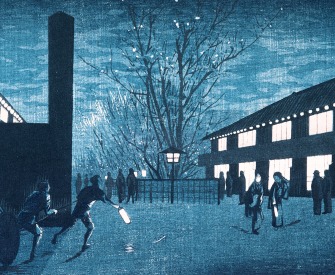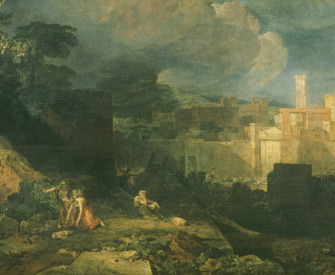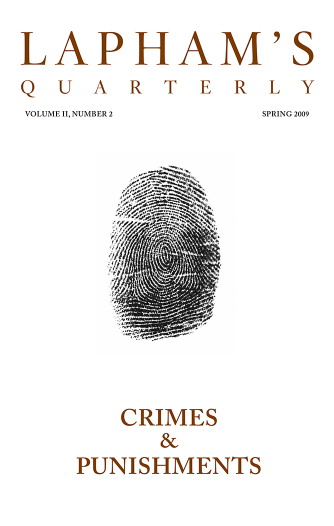Music melts all the separate parts of our bodies together.
—Anaïs Nin, 1939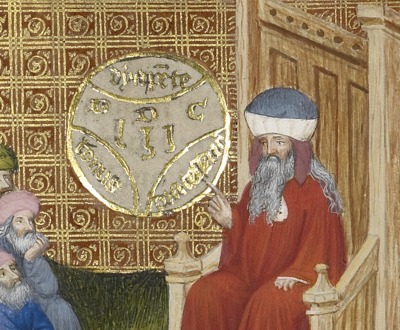
Boethius Discusses Music with a Group of Men, miniature from a c. 1405 edition of Boethius’ Fundamentals of Music. © The J. Paul Getty Museum, Los Angeles.
The last time I spoke with Sun Ra, I asked him for his take on the enduring legacy of the Great American Songbook. It was 1993. Ra had returned to Birmingham, Alabama, where he’d been born nearly eighty years before. He would die there, from complications associated with pneumonia, a few weeks later. The pianist, composer, and bandleader’s first published composition, “Alone with Just a Memory of You,” written in 1936 together with Henry McCellons, conveyed a tender, awkward Tin Pan Alley tone that betrayed his love of sentimental songcraft. This passion is driven home repeatedly in a survey of Ra’s magnificently gigantic discography. He employed anachronistic singers like Clyde Williams and Hattie Randolph. He played familiar compositions with double-entendre titles especially meaningful to him, such as “East of the Sun,” “Keep Your Sunny Side Up,” “I Dream Too Much,” “Out of Nowhere,” “This Is Always,” “Second Star to the Right,” and “Over the Rainbow.” Never mind that Ra is known as one of the most adventurous and innovative figures in the history of the twentieth century. That he brought synthesizers to jazz. That his costumes and light shows paved the way for psychedelic rock. That he wrote apocalyptic and deeply philosophical poetry. That he identified as an extraterrestrial. That outer space and the unknown featured as prominently as ancient Egypt in his unique proto-Afrofuturist weltanschauung, which often manifested as a circus-like performance troupe that he called the Arkestra.
Ra couldn’t resist a good song.
He replied to my question in his typically elliptical fashion, asking me to consider his interest in comic books. The reason he read comics, especially when he was a young musician, he told me, was that the artists who made them worked within a set format and had crazy deadlines, which meant they had to be creative under pressure. They didn’t have the luxury of space or time. The great ones rose out of that homogenizing environment and the individual spark ignited by their work did so in such a strict context that its genius was undeniable. So, too, he figured, with Jerome Kern, the Gershwins, and Cole Porter. They had expressed their ingenuity in an especially claustrophobic and constraining genre: the popular Broadway show tune.
It’s after midnight at the Zig Zag Tavern, a strip club so named for its staggered stage shows and the way its leering clientele darts between them. The year is 1951. Sun Ra is at the piano, right hand playing a bluesy ostinato, left hand leaving the keyboard for a moment to flip the page of Schopenhauer’s On the Freedom of the Will, propped up on the piano lid. A chorus of whoops and hollers erupts from in front of the white sheet behind which he and his bandmates are situated. Ra recognizes the cue and begins a volume swell. One by one, articles of women’s clothing are tossed into the air, appearing for a flash above the white curtain. Ra nods at drummer Tommy “Bugs” Hunter, who winds up and begins to deliver a bump-and-grind beat, tenor saxophonist Red Holloway ladling on some extra groove juice. They have been there since six o’clock and will be there until the other six o’clock. His accomplices have been relieved at intervals by other musicians, but not Ra. He will play behind the strippers, various emcees, an occasional comedian, through the night. The piece is finished, panties finally flung high, accompanied by wolfish sounds, and now the pianist is up adjusting his tape recorder, changing the reel, and waiting for the next girl to hit the stage. He’s closed Schopenhauer and opened the latest edition of John Carter of Mars, a comic book modeled on Buck Rogers. For the rest of the night, when he’s not gnawing a sandwich from the bar or running back and forth to the toilet, Ra will read and record and perform, an eager multitasker.
Ra played at strip clubs and speakeasies in Calumet City, Illinois, in the 1940s and early 1950s. With hundreds of bars and dozens of clubs, all controlled by the Mafia, Cal City’s State Street was widely known as Sin Strip, a simmering destination with a semilegit facade (fancy ballrooms and floor shows from Sally Rand to Dizzy Gillespie) and a bad reputation. Both the opulence and depravity were made possible because Calumet City was a booze-friendly town during Prohibition, servicing nearby industrial cities Hammond and Gary, Indiana, and attracting visitors from Chicago, twenty miles to the north, and beyond. Little remembered now but once a household name, Cal City presaged Las Vegas as a vice mecca and was for a period in the 1920s one of the premier gambling spots in the United States.
Sin Strip was also a popular port of call for musicians from the Windy City, who looked there for work outside the union and payment under the table. Ever since its association with the brothels of New Orleans, jazz had a lingering connection with the underworld, one that lasted longer than is often imagined, into a time when mainstream clubs were sometimes run by the mob, and musicians—even innovative, brilliant ones like Ra—were so desperate for work that they took jobs at go-go venues. In Cal City the labor was not lucrative, but if you wanted it, with so many clubs, work was plentiful. Those musicians could do whatever they wanted, so long as the music fulfilled its function, which made it a great place to hone your chops and work on stamina, often in the company of top-shelf colleagues. As Ra told Dave Hoekstra in 1987, “All they wanted you to do was swing.” He added, “Some of the best drummers played the Street. The strippers always had to have a good drummer—for their bumps, you know.”
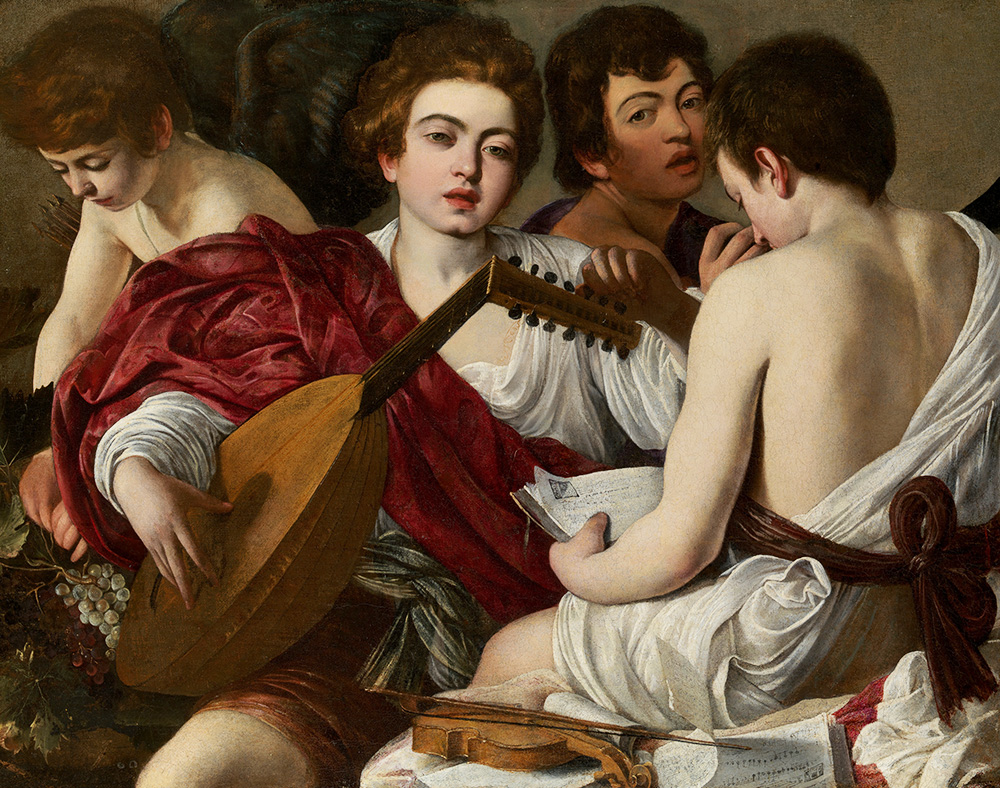
The Musicians, by Caravaggio, c. 1595. © The Metropolitan Museum of Art, Rogers Fund, 1952.
In her book Striptease: The Untold History of the Girlie Show, Rachel Shteir describes a couple of scenes: “In Cal City, the cheap and tawdry strip acts verged on sex shows. In ‘The Devil and the Virgin,’ the virgin undressed, coerced by a devil in white tie and tails. Cal City’s most decadent act was a stripper named Roszina’s ‘Beauty and the Beast’ number. She began wearing a gorilla costume on one side of her body and a strip outfit on the other. As the music got wilder, the ‘gorilla’ would rip the strip costume from the stripper’s body. The lights faded with the ‘gorilla’ on top of the ‘stripper.’ ”
Alton Abraham, who was Ra’s manager and closest adviser through the Chicago years and into the 1960s, told me that the Calumet City gigs were incredibly rough, especially for black musicians. Robert Barry, who drummed with Ra in many of those strip clubs, confirmed this impression, saying that, along with the dangers of gambling misunderstandings and drunken fights, there were other perils: the club owners were mob connected; some of the understaffed police department was on the take; and there was an overall sense of self-rule to the nightlife. Barry saw two men beaten to death with metal pipes for not paying a bar tab, and he watched as a fellow musician was thrown through a plate-glass window for messing with the strippers. Knives were common. Guns were not unfamiliar. It was a classic wide-open town.
Ra told Hoekstra about one of the emcees: “He was the ‘Man with the Glass Head.’ He had music to it, and the club’s other pianist always played for him. One night the other pianist had to go across the street and play for Charlie Ventura, and I had to play for the Man with the Glass Head. So the Man with the Glass Head got up and said he couldn’t do his usual bit because he had a different pianist. I got mad, and I hit a chord on the piano, and everything on the piano—the music, the flowers—all jumped to the floor. He turned around and looked at me, and said, ‘On second thought, uh, I think I will do that. Just play whatever you want to.’ When I got through playing for him, he said it was the best music he ever heard.”
William “Bugs” Cochran lived at Fifty-Fourth Street and Prairie Avenue on Chicago’s South Side. As a youngster, he played in the alley, where he often heard the Freeman brothers—saxophonist Von, guitarist George, and drummer Bruz—rehearsing in their garage. From his front door, any way you went there were musicians. Drummers Robert Barry and Walter Perkins lived around the corner. Saxophonist John Gilmore lived across the street. Von lived a block down Prairie. And Sun Ra lived right next door. Cochran started playing jazz drums. Before long he was part of the Ra coterie. “I didn’t see it as such an experience at the time, but later it stood out,” he says. It was the early 1950s. The band, which was not yet called the Arkestra, was sometimes using two bassists and two drummers plus timpani, creating a thicket of rhythm, including odd time signatures. Ra’s music had a different sensibility from the soul jazz and ballads that Cochran would play in his trio with organist Sleepy Anderson and guitarist Leo Blevins, sometimes adding Gene Ammons (when he was out of jail) on tenor sax. Not only would Ra’s band play adventurous modern music but he’d transform corny tunes into something fresh. “We had a jazz thing on ‘Take Me Out to the Ball Game,’ little twists, you know, not what you’d normally hear.”
Music sweeps by me as a messenger / Carrying a message that is not for me.
—George Eliot, 1868On off nights, Cochran might pick up work at Minsky’s Rialto burlesque house at State and Van Buren or the Admiral Theater up on Lawrence Avenue, backing strippers, picking up a few bucks. One night Ra invited him to play in Calumet City. The trio consisted of Ra on the forgotten club’s upright piano, a trumpeter named Arthur, and Cochran, barely twenty-one, on drums. Cochran picked the others up in his gray Oldsmobile 88, his Slingerland kit hiding in the car’s giant trunk. They drove straight down Halsted Street, as there was no expressway yet, eventually turning east, arriving while the sun was going down and leaving when it was coming up.
The band took no breaks, but each musician periodically sat out, running down the block for a hot dog, while the others kept the action hopping. “They had some rough characters out there,” says Cochran. “Musicians worked behind a cloth sheet. You did what you needed to do and then left, otherwise they’d bring the heat down on you. I was just in, agewise, so I kept it cool. We played standard tunes, something the girls could dance to, kept in a danceable tempo. If you didn’t get involved, didn’t mess with the girls, just got to business, everything was all right.”
When Ra moved to New York in 1961, there wasn’t much work to support him and the small band that had traveled there with him. These were lean years in the Village. Abraham would wire small amounts of money via Western Union, a couple of dollars at a time, maybe lunch money for the guys or funds for blank tape. In spite of those challenges, Ra didn’t choose to play mainstream jazz at that time as a way of making the bills, as he might have. Rehearsing and recording at the Choreographer’s Workshop and then at his home (which he called Sun Studios), he not only persisted in advancing his music, he also built the Arkestra back up in size, adding key new players and issuing numerous LPs on his own Saturn label, many of them featuring the music he had recorded while in Chicago.
Ra’s sidemen were dedicated. Extremely so. Still, in this money vacuum, even his featured tenor saxophonist, John Gilmore, took more than a year’s hiatus to join Art Blakey’s Jazz Messengers and record with McCoy Tyner, Paul Bley, Andrew Hill, Freddie Hubbard, and Elmo Hope. What did the leader and mentor Ra take on as support work? Instead of joining the jazz mainstream, which might have meant playing hard bop, he took commercial jobs making kitschy, lowbrow recordings like How Low Can You Go? (with Roz Croney, Queen of the Limbo) and Batman and Robin (with the Sensational Guitars of Dan and Dale, a group including some Arkestra members).

Improvisation No. 29 (The Swan), by Vasily Kandinsky, 1912. © Philadelphia Museum of Art, Louise and Walter Arensberg Collection, 1950.
There is reason to believe Ra didn’t take this work strictly for dough. As a parallel fascination to his interest in the Great American Songbook, which he said he grew to know in depth playing in Calumet City, he was also interested in exotica, then a popular genre of recording. Ra’s 1959 LP, Jazz in Silhouette, has shades of the slinky adaptations of Latin music typical of exotica artists like Juan García Esquivel and Martin Denny, as well as “Hours After,” a blues track lascivious enough to have been at home in a burlesque parlor. For Ra these were seductive alien universes. In the terminology he would adopt later, exotica offered an “alter-destiny,” a compound and wholly constructed alternative reality in which otherness is embraced, disparate bits of jazz, experimental music, and tropical make-believe are patched together by means of “myth-science,” meant to be enjoyed through the ears as a journey out of one’s own limited biosphere.
Back in Calumet City: Why the sheet? Ra told his biographer John Szwed that he had called it “the iron curtain.” It was there, Abraham explained to me, with a dual purpose. First, it kept the customers, who were almost always white, from seeing the band. But more important, it kept the band, with few exceptions African American, from seeing the girls. The racist assumption was that they would not be able to control themselves. Beauty and the beast. The gorilla and the stripper. It still boggles the mind: What the hell was a self-styled prophet like Sun Ra doing in a joint like this?
What is the proper distance between sleaze and the sublime? Pulp and the extra-precious? Trash and the timeless? Maybe the answer is pragmatic: as close as it needs to be. Or is there more to it than expediency? Perhaps bringing together something utterly disposable and something with lasting brilliance involves an avoidance of the safe middle, where the extremes are pushed away and a reliable averageness is embraced. In certain cases, you could say, vice and the visionary are but footsteps apart. Maybe all that separates them is a white sheet.
